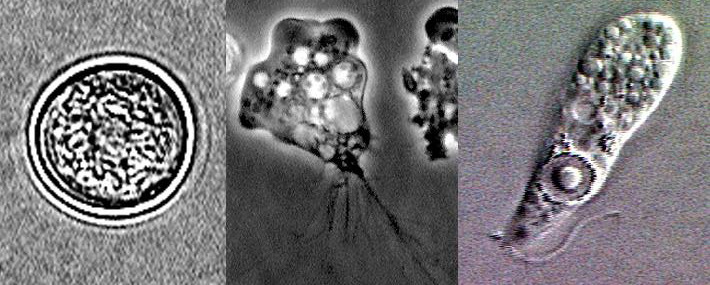TL:DR – The brain-eating amoeba, Naegleria fowleri, does not eat brains but it can cause fatal brain swelling. Avoid it by only using sterile water for nasal irrigation and a noseclip when swimming in warm freshwater lakes.
Mrs Sciencebase was a yoga teacher for 20 years or thereabouts and one of the most peculiar aspects of that art was the use of the neti pot. A kind of jug with a long spout that allowed to pour a little water into your nostrils as part of a cleansing ritual. Technically known as nasal irrigation, but put simply it’s nothing more than pouring water into your nose.

It always struck me as a bit pointless, most of our bodily orifices are self-cleaning except perhaps when there is disease present and a trip to the doctor’s is recommend rather than a random infusion (see also douching, coffee enemas, ear candling etc). I should point out that Mrs Sciencebase was not a practitioner of this particular aspect of yoga.
Either way nowhere in the human laundry instructions does it say that our bodily orifices need any kind of irrigation. Of course, those same instructions also don’t mention climbing into the tumble dryer after a shower.
With all this in mind, I was a little bemused to hear of tabloid headlines (via @SophWarnes on twitter) of the case of a Florida man who died after irrigating his nostrils. Apparently a rare brain-eating amoeba, which goes by the name of Naegleria fowleri. This single-celled organism lives in fresh water and soil. It’s not a brain eater but if it gets into your head (via your nostrils) it can cause brain swelling with a high chance of death.
Primary amoebic meningoencephalitis (PAM) initially causes symptoms that are a bit like meningitis – fever, severe headache, nausea and vomiting. These can develop into stiff neck, light sensitivity, confusion, loss of balance hallucinations, seizures, and potentially death. It is worth noting that the amoeba does not eat brains. And, there were only 34 reported fatal cases in the USA according to the Centers for Disease Control (CDC). Most cases arose when someone was exposed to the pathogen when swimming in warm freshwater lakes or heated swimming pools that were not properly chlorinated. There is very little risk of PAM from drinking tap water.
The Healthline website has some advice for neti pot users. Basically, you should boil and coil tapwater you intend to use in your neti pot or buy sterilised water. Water filtered to NSF standard 53 should also be safe, according to the site.
Because PAM is so rare, studies and clinical trials for treatments are rare too. There is evidence that the antifungal agent, amphotericin B, injected close to the spinal cord can help. There is also some evidence that other antifungal agents have activity against N. fowleri: miltefosine, fluconazole, and azithromycin. The antibiotic rifampin may also work but would be contraindicated if an antifungal was being used, reports Healthline.
N. fowleri is very much a rare hazard of warm freshwater and so is generally present in the southern US states, but is also found in most other parts of the world – Australia, Africa, Asia, Europe, and Latin America. It might be assumed that with global warming, we are likely to see its presence in bodies of freshwater reaching further north from these regions.
